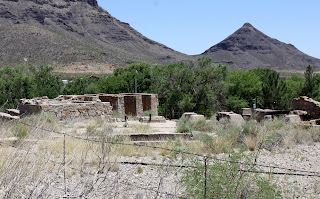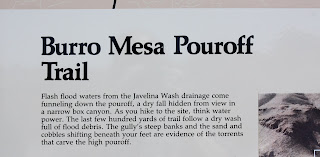MAY 22 BIG BEND NATIONAL PARK – 3RD AND FINAL DAY
Today will be our 3rd and final day in Big Bend
National Park. It took 13 years of
planning, ohhh well, 13 years of procrastinating but we finally got here. It would have been a shame to miss this, it
is indeed pretty spectacular. Kathy was
able to take one picture that we feel exemplifies Big Bend National Park.
Unfortunately it looks like today is not the best day to be
in the Park as there is a haze covering the mountains. It almost looks like fog but it is dust. Hopefully it will clear up later in the
day. You can still see everything close up;
it is just the panoramic views that lose their focus.
We continued into the park until we came to the visitors
centre and swung south east towards Rio Grande Village. We dropped down onto the flats with the
Chisos Mountains on our right passing by Pummel Peak, Nugent Mountain and
Panther Peak. On the right we had the
Sierra Del Carmen Mountains. I knew this
because it says so on our map, we still couldn’t see them. We could distinguish them but that was about
all.
We were able to enjoy the scenery closer to us with stops at
Rio Grande Overlook and Boquillas Canyon Overlook. You could see the village of Boquillas Del
Carmen across the river on the Mexican side.
Free enterprise was at work at the turnaround at the Boquillas Canyon Overlook. Venders from Mexico would bring over knickknacks and lay them out on the rocks with price lists for people to buy. You could also see the watchers across the river keeping an eye on their product. They had some neat stuff but if you bought any of it you were breaking 2 federal laws. They weren’t that nice.
We stopped at the Visitor’s Center
only to find out it was closed, so we explored the campgrounds to see what they
had. You could also tell we were pretty
close to the river as the vegetation certainly took on a non desert look. Unfortunately it was only right along side of
the river.
We also got a couple of pictures of the State Bird of Texas

We had some lunch and then headed for the last place in the park that we still had to explore, Chisos Basin. We weren’t too optimistic as the haze was still in the air but as it turns out we were very pleasantly surprised. Once we started to climb into the Chisos Mountains on our way to the basin the sky became very clear allowing us to take some very nice.
The most amazing aspect of the Chisos Basin is the terrain
and vegetation. After spending two days
in the park looking at scrub land, cactus and barren mountains it was with awe and
amazement to discover mountains with green vegetation. This area if the park was lush but to the
rangers in the park the area was in distress as they have only had 4.2 inches
of rain in the past two years. However
to us it was like being in a different park.
The entire Chihuahuan Desert was like this 8000 years ago, very lush and
full of vegetation. Over time the harsh
and arid climate has changed most of the desert into what we see today. The exception is the Chisos Basin which is
considered an agricultural island as it is protected by the mountains and it
also gets more precipitation. It was
really was amazing. There are Aspens growing
the Basin, the only place in Texas where you will see aspens. It is the only place in the Park where you
will see Mountain Lions, Bears and White Tailed Deer. We absolutely loved it.
 |
| Emery Peak - Highest in Big Bend |
 |
| Casa Grande |
















































.jpg)




































